I had been waiting for a few hours, standing in the dark. I was on a ridge above a glacial lake. I was cold. It was below freezing. I could not feel my fingers. My hands were digging in my pockets, looking for some remnants of heat from the hand warmers I placed there hours prior. I had two cameras on a tripod taking photos on a timer. My nose was running. My face was so numb I cannot feel it. I thought I must be nuts to waiting there in the cold. Then all of a sudden, when I thought it was a dud of a night, I saw the lights begin dancing across the sky. I was grinning from ear to ear when the Aurora finally showed up! The greenish cloud-like lights slowly dance over the floating icebergs of Jökulsárlón Glacier Lagoon in Iceland. It is mesmerizingly beautiful like its namesake, the goddess of dawn. With my cameras already snapping photos, I enjoyed just watching the show. It is a phenomenon that needs to be experienced in person to have its beauty truly appreciated. My face was frozen stiff, but that didn’t stop me from smiling.
The Aurora is a naturally occurring lights show in the sky near the Arctic and Antarctic circles. In the Arctic, it is called the Aurora Borealis or Northern Lights, and in the Antarctic, it is called the Aurora Australis or Southern Lights. The lights are formed when solar winds from the sun collide with charged particles in the sky and emit lights of varying colors, complexities, and intensities.
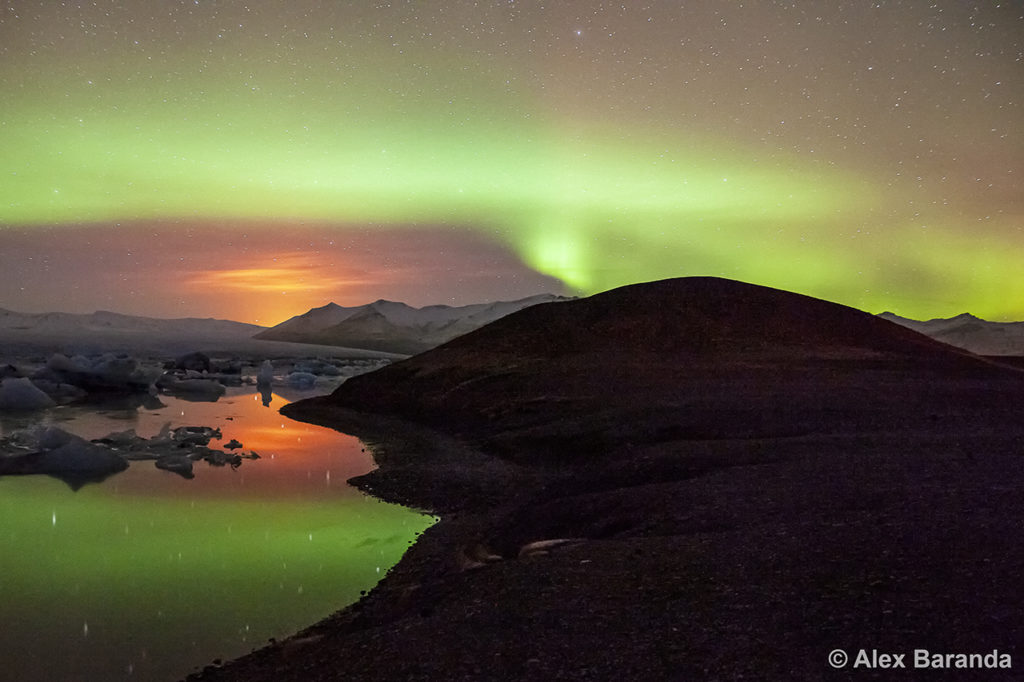
The Northern Lights frequently occur in the Auroral zone, which extends over Northern Scandinavia, Iceland, the southern tip of Greenland, and continuing over to Northern Canada, Alaska, and along the northern coast of Siberia. Sometimes when strong geomagnetic storms occur, the Aurora can be seen as far as the lower 48 of the United States.
The Southern Lights occur mainly in Antarctica, but it can be faintly seen in Australia, New Zealand, Argentina, and Chile.
I had a glimpse of the Northern Lights when I was in Fairbanks, Alaska, a few years ago in negative 20 degrees Fahrenheit temperature. It was a beautiful experience and quite addictive. Despite the extreme cold conditions, I wanted to see more. Just like any natural phenomenon, the lights are different with each experience. As a photographer, I not only wanted to see but photograph the lights as well. In photography, composition and foreground are as crucial as the subject itself. While the lights were amazing in Alaska, my photographs were of the beautiful Aurora, but only over trees. I love the photos, but I wanted to get different foregrounds to go along with the lights.
The two nearest options were Canada and Iceland. I decided to go to Iceland because it had more varieties to take photographs like waterfalls, black sand beaches, lagoons, fjords, ice caves, etc. I did my research and was definitely in awe of the beauty of the country.
Experts say that there are three main conditions to see and photograph an excellent light show: dark, clear, and cold. The window (Northern Lights season) is between October and March. It occurs when it is dark enough near the Arctic as the daylight hours are almost 24 hours during the other months. Clear is the main issue with Iceland as the cloud cover, rain, and snow are prevalent during those winter months. I wanted to give myself multiple chances in seeing the Northern Lights, so my trip was for nine days, including travel. And the cold? It’s always cold in Iceland during winter.
My trip consisted mainly of exploring the south of Iceland from Reykjavik (West) towards Jökulsárlón (East) along the Ring Road, the main road that circumnavigates the island nation. I drove through the Golden Circle, a region where many tourists go to visit. The route showcases Thingvellir National Park, a UNESCO World Heritage Site, and the massive waterfall Gulfoss.
Any of these locations had good foreground for the lights. Many tourists just do a night tour from Reykjavik. However, I just had my mind already set on the glacial lake, Jökulsárlón.

I stayed at Hotel Hekla, which was practically in the middle of nowhere just outside of the Golden Circle, on my way East. I only found the place in the dark because of GPS. It was only 7 in the evening, but it’s been dark for a few hours. I was definitely away from the city at that point, but I walked around the property after dinner. The clouds were still overhead, so the chances of seeing the lights were slim to none. I went to bed early only to be awakened around midnight. A tour group stayed at the same hotel, and people were knocking on doors to wake people up. I heard some yelling, “lights!” I got my camera gear and went out. I was half-awake and walked out in my nightclothes of t-shirt and pajama bottoms. It was below freezing in single digits (Fahrenheit). I was already out and saw the lights, so I proceeded to take photographs. I lasted perhaps 10 minutes before I could no longer endure the cold. I went back into my hotel room and came out with better cold-weather clothing, but alas, the lights were no longer visible. The Northern Lights go in and out. The phenomenon is not always on, unfortunately. I checked for the lights a couple of times during the night but to no avail.
I had a long drive the following day towards Skaftafell near the edge of Europe’s largest glacier, Vatnajökull. I was treated to amazing sights such as the waterfall Skogafoss, a 197-feet giant, as well as the black sand coastline of the small village Vik. It was very late when I arrived at Hotel Skaftafell, and the worse thing was that it started snowing.
It snowed overnight, so I had to clear the snow that buried my SUV in the morning. I drove out around 7 in the morning. The hotel receptionist mentioned that I should be okay driving as it was not windy. There have been many vehicles that got swept out of the Ring Road in Iceland.
After exploring ice caves, I finally arrived at a bucket list destination, the Jökulsárlón Glacier Lagoon. Icebergs floated in the lagoon. It is at the edge of Vatnajökull National Park and in the receiving end of the receding glacier. The procession of luminous blue icebergs floated towards the sea. I explored the lagoon and took several photographs from every angle and location I explored. I checked-in to my hotel in nearby Hali. After dinner, I came back, hoping for the lights.
I had picked a spot near the parking lot. I figured that if it got too cold, I could take refuge in the car while waiting. I set up two cameras, each with a slightly different composition. I did a few test shots to make sure the exposures were correct, and the cameras were in focus. I had set them at 30 seconds exposure wide open (f/2.8 aperture) at a high ISO of 1600. Taking photos of the lights pushed the limits of my camera gear. I had turned off autofocus, so the cameras would not hunt for focus every shot. With an intervalometer, the two cameras were taking photos continuously.
I found myself pacing to warm up a little. A few other people began to arrive in Jökulsárlón. They had the same idea to photograph the Northern Lights with the glacial lake. I thought about moving my spot farther into the lagoon, but I stayed as I liked my compositions.
After a couple of hours at around midnight, I still could not see any hint of the lights. I checked the Aurora forecast. The kp index was about 3, so it was an excellent chance to see the Aurora. The kp number system is just a scale of geomagnetic activity. At kp 3, bright Auroras can be visible but can still be a big miss. I was hoping for a kp of at least 4, where the lights would be more active. Kps of 5 through 8 happen when there is a geomagnetic storm (minor to intense levels).
A few people started leaving at around 1 in the morning. The lights finally showed up before 2. I spent another hour before calling it a night. The one bonus of my photographs was the hint of orange glow from the recent volcanic eruptions of the Bárðarbunga.

The weather never cooperated after that night. While I enjoyed the fantastic Iceland, I wanted more lights, but to no avail. That is the bane of trying to see and photograph natural phenomena. It can be a hit or miss. Probably more misses than hits. I visited Iceland once more after. The kp index was 8, a severe geomagnetic storm. That would have been an amazing show. Mother nature had other ideas as the clouds obscure the sky in the two nights I was there. The reward is great, but often, it will be a miss. However, I shall continue chasing the lights.
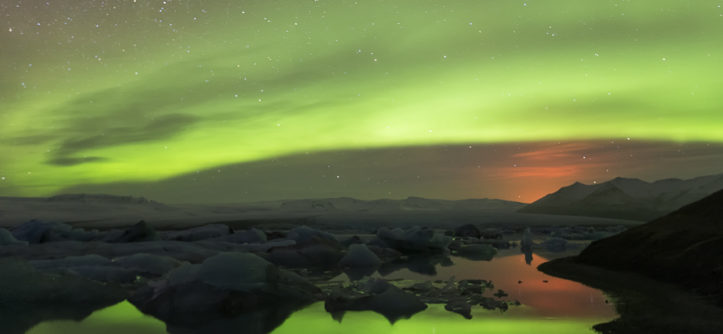
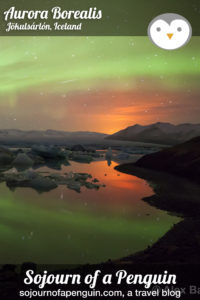
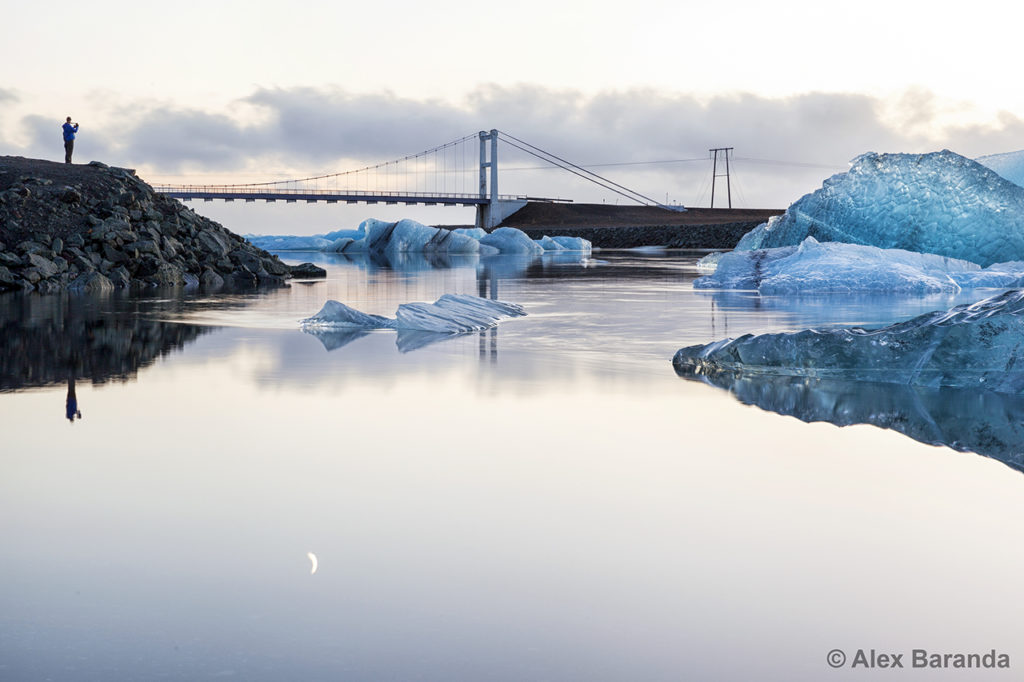


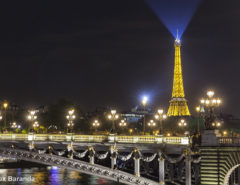
It looks so magical! Visiting the Northern Lights is on my bucket list – hopefully in the near future! ?
Thanks! The chase is worth it.
Iceland was on the list for this year but for the pandemic. Next year for sure.
It’s an amazing place. You’ll enjoy Iceland.
Wow, these photos are amazing, considering how much time and effort they’d need to be captured. I applaud you for managing the cold, which I wouldn’t be able to!
It’s worth it 🙂
This is breathtaking! Stunning photos! Iceland has been on my bucket list for so long! I really want to go before 2022!
It’s an amazing place. I’ve been twice and still not enough 🙂
Wow! This looks so beautiful! Magical like! Seems like out of a fairy tale…This is definitely on my travel bucket list ..
It’s worth a visit.
Oh wow! You got some stunning pics! It looks such a beautiful place to visit.
It is an amazing place. I would like to visit again!
These photos are absolutely stunning! What an amazing place!
Thanks!
How beautiful! What a cool experience!
Well written article! One of my favorite destinations I’ve traveled is Tromsø Norway. It’s 200 miles up the Arctic in Scandinavia. Your pictures are stunning! One thing I would suggest that may help your article is perhaps elaborating on why the cold was so thrilling. Zoom into a moment and touch to the senses. I think that might help create something tangible for the audience. Other than that, great work!
Just magical. This would be my dream trip.
I long to see those lights at least once in my life! They really look magnificent and surely no amount as to how people would feel if they’re up close personally seeing it. I love how you write this post seeing you are as patient to be able to capture this beauty. Thanks for sharing this wonderful article ??✨